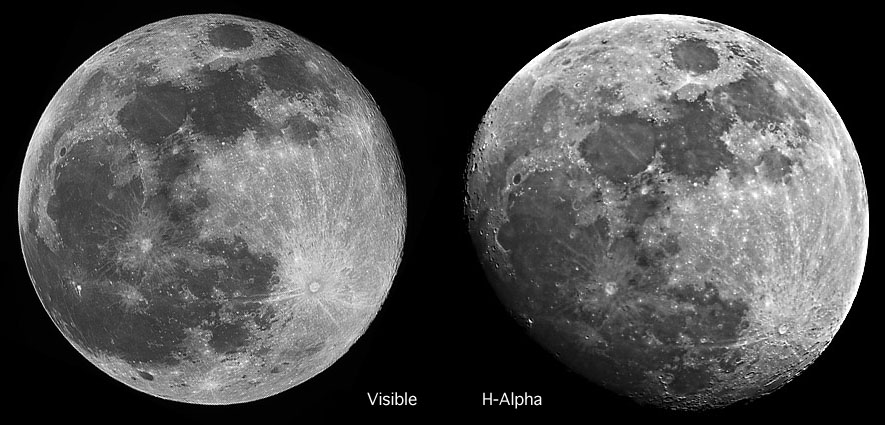Difference between revisions of "October 22, 2004"
| Line 3: | Line 3: | ||
<table width="85%" border="0" align="center" cellpadding="6" cellspacing="2"> | <table width="85%" border="0" align="center" cellpadding="6" cellspacing="2"> | ||
<tr> | <tr> | ||
| − | |||
</tr> | </tr> | ||
</table> | </table> | ||
| Line 21: | Line 20: | ||
<p align="center"><b>H-Alpha Moon</b></p> | <p align="center"><b>H-Alpha Moon</b></p> | ||
<p align="left">Most images of the Moon are taken in visible light, which is where human eyes are most sensitive. But here (right) is one taken through a hydrogen-alpha filter which is normally used to image the Sun in a narrow red part (656.3 nm) of the visible spectrum. I compare this image to Frank's previous [[February_16,_2004|LPOD]] (and [http://antwrp.gsfc.nasa.gov/apod/ap031212.html APOD]!) image on the left which was taken in visible light. I enhanced both images, making comparison a little uncertain. Nevertheless, there are a few interesting comparisons. first, the two images look quite similar - probably because the Sun is quite bright at H-alpha wavelengths, contributing significantly to its total visible brightness. Second, there are some differences. In H-alpha, Mare Nectaris is more muted - the rays that cross it are more strongly depicted. The same seems true for maria Fecunditatis and Crisium - both are low in titanium. Additionally, the dark mare patches south of Mare Serenitatis have more contrast on the H-alpha image. Frank's image suggests that amateurs may want to experiment imaging the Moon thru different color filters to explore compositional differences in the maria. </p> | <p align="left">Most images of the Moon are taken in visible light, which is where human eyes are most sensitive. But here (right) is one taken through a hydrogen-alpha filter which is normally used to image the Sun in a narrow red part (656.3 nm) of the visible spectrum. I compare this image to Frank's previous [[February_16,_2004|LPOD]] (and [http://antwrp.gsfc.nasa.gov/apod/ap031212.html APOD]!) image on the left which was taken in visible light. I enhanced both images, making comparison a little uncertain. Nevertheless, there are a few interesting comparisons. first, the two images look quite similar - probably because the Sun is quite bright at H-alpha wavelengths, contributing significantly to its total visible brightness. Second, there are some differences. In H-alpha, Mare Nectaris is more muted - the rays that cross it are more strongly depicted. The same seems true for maria Fecunditatis and Crisium - both are low in titanium. Additionally, the dark mare patches south of Mare Serenitatis have more contrast on the H-alpha image. Frank's image suggests that amateurs may want to experiment imaging the Moon thru different color filters to explore compositional differences in the maria. </p> | ||
| − | <blockquote><p align="right">— [mailto:tychocrater@yahoo.com Chuck Wood]</blockquote> | + | <blockquote> |
| − | <p align="left" | + | <p align="right">— [mailto:tychocrater@yahoo.com Chuck Wood]</blockquote> |
| + | <p align="left"><b>Technical Details:</b><br> | ||
Right image: Sept 25, 2004. Orion 80 mm ED + SBIG ST7E camera + Schuler 10nm H-alpha filter. Mosaic of two 110 ms exposures. CAW ehhanced with unsharp mask. Left image: Dec 9, 2003. Celestron C8 SCT with a SBIG ST-7E ccd camera and an Orion Moon Filter to capture 18 frames at 110 ms each which were mosaicked into this image.</p> | Right image: Sept 25, 2004. Orion 80 mm ED + SBIG ST7E camera + Schuler 10nm H-alpha filter. Mosaic of two 110 ms exposures. CAW ehhanced with unsharp mask. Left image: Dec 9, 2003. Celestron C8 SCT with a SBIG ST-7E ccd camera and an Orion Moon Filter to capture 18 frames at 110 ms each which were mosaicked into this image.</p> | ||
<p><b>Related Links:</b><br> | <p><b>Related Links:</b><br> | ||
Revision as of 17:58, 17 January 2015
H-Alpha Moon
Image Credit: Frank Barrett
|
|
H-Alpha Moon Most images of the Moon are taken in visible light, which is where human eyes are most sensitive. But here (right) is one taken through a hydrogen-alpha filter which is normally used to image the Sun in a narrow red part (656.3 nm) of the visible spectrum. I compare this image to Frank's previous LPOD (and APOD!) image on the left which was taken in visible light. I enhanced both images, making comparison a little uncertain. Nevertheless, there are a few interesting comparisons. first, the two images look quite similar - probably because the Sun is quite bright at H-alpha wavelengths, contributing significantly to its total visible brightness. Second, there are some differences. In H-alpha, Mare Nectaris is more muted - the rays that cross it are more strongly depicted. The same seems true for maria Fecunditatis and Crisium - both are low in titanium. Additionally, the dark mare patches south of Mare Serenitatis have more contrast on the H-alpha image. Frank's image suggests that amateurs may want to experiment imaging the Moon thru different color filters to explore compositional differences in the maria. Technical Details: Related Links: Tomorrow's LPOD: Imaging the First Lunar Photographer |
|
Author & Editor: Technical Consultant: Contact Translator: A service of: |
COMMENTS?
Register, and click on the Discussion tab at the top of the page.




